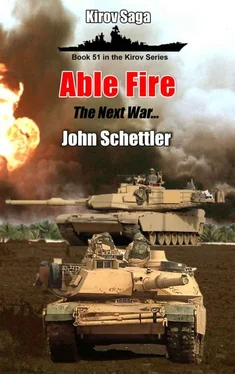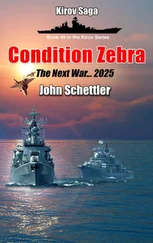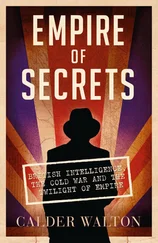Bright Eyes would take the first bite out of the missile storm. Each plane could carry 6 of the new AIM-260 missiles, which were available in limited supply, and there were plenty of the older AIM-120s available too. Today they had the better missiles, and could engage at range. As they fired the last of them, turning for the carrier, they saw the SAM’s rising from the escorts—SM-6.
Carrier Strike Group Washington , like all US Strike Groups, was well defended. A ship that had campaigned with Karpov in the Sea of Japan had patched up light damage sustained there, and now Captain Rose had taken the big new battlecruiser Kentucky south to join the Washington . That ship alone had tremendous firepower, and it was joined by a CG-21 Class cruiser the Santa Fe , and destroyers JEB Stuart, Jenkins, Hampton and the Nathan Bedford Forrest , all named for famous Confederate Cavalry officers from the Civil War.
In this world, no one had to fuss with the silly need to be “politically correct,” in regards to these ship names. History was history, and there were still statues of Robert E. Lee up in the south. The history would not be expunged as if it had never happened simply because the South once held up the institution of slavery, and George Washington’s face would not be removed from the dollar because he was a former slave owner either. The world had grown up a bit in these matters, realizing that the statues and flags from that unfortunate conflict were emblems of that history, and not banners for modern day right wing minds to rally around.
Together these ships combined to muster up 400 ESSM’s, a huge allotment of 260 SM-6’s, and 80 SM-3’s to protect against ballistic missile threats too. Add in the RIM-116C’s on the carrier itself, and Captain Rayburn’s group was defended by 700 SAM’s. Add to that the missiles he could put in the weapons bays and wings of his fighters, and the Strike Group was damn near invulnerable. So anything that came his way probably going to die, which was now a good chunk of that cloud of Vampires out there, which just seemed to be getting bigger and wider as the minutes passed, but they were dying.
Of the 126 cruise missiles fired by the bombers, only about 20 survived to slip by Carrier Strike Group Washington far to the south. The long reach of Standard Missile-6 was lethal in gutting the center of the wave.
Yap also issued a similar scramble order to send its air assets up to join the fray. Six F-24’s would rise to the defense of the base, but other planes carrying strike ordnance were ordered up too, just in case. At Palau, nothing wicked seemed to be heading their way, but the order went out to get fighters up on defensive patrols.
The first inkling of trouble for Palau was the appearance of Vampires 50 miles north of SAG Guam. That started the ESSM fire by San Jacinto and the two destroyers, the missiles lancing out to destroy one group of Vampires, only to see more groups appearing on the radar screens seconds later. Some on a wide vector to avoid the US ships were now seen 40 miles from Palau, prompting immediate fire by the patriot battery stationed there. Anything that got past the ships and fighters then had to face those land based SAM’s. In the end, only two of 64 would survive and get in to attack the base, and one of those would be shot down. Only one lonesome Vampire reached Anderson AFB on Guam, doing no significant damage, and Yap was completely untouched.
16:00 Local, 18 JAN 2026
Wu Jinlong’s second big strike had gone bust. It would now be another 16 hours or longer before the War Gods could rearm, and given limited missile inventories in the Philippines, only a portion of those planes might be available for operations the next day. All the Naval SCALP missiles on the four Vietnamese destroyers had been expended, and with little result. Once again, he had underestimated the tremendous defensive power on the American side, and now he knew that the US Admirals and Captains would begin to consider their own offensive operations soon.
The Chinese fleet was presently about 200 miles southwest of Davao, but the Admiral had no further ordnance to strike at any of his mission targets. The only way he could wrangle any sense of victory from this situation now was to do so by engaging one or another of the American carriers.
There is no way I will operate out in the Pacific, he realized. At the moment, I am within striking range of the American Surface Action Group, but we must wait for yaogan-13 to give us a chance at getting a target fix… Unless I order the Flying Leopards at Davao to make their strike.
Yet something tells me that would be fruitless. As long as that SAG is there, Palau will be well defended. So I must decide where to engage. Do I strike the American SAG, or return to the Celebes Sea and face the Enterprise ? The latter seems to be the wiser course. From a position southeast of Davao in the Moro Gulf, I have fighter support from that airfield, as well as the planes now basing at Zambangoa. That course also moves me to a position to restore my communications back to China. So that will be the order.
At every turn, I do what seems most reasonable, most sound in military terms, and yet, I have so little to show for it! Am I being overly cautious? Thus far, I have at least successfully covered the supply lift to Davao, and we have troops there now—a solid footing on Mindanao. While I have failed to hurt Guam, or the other island bases as I had hoped, I see the folly of that now. It only buys us time. Yet I can operate in the Celebes Sea, and stay there, if I wish, and that is what I will do.
When I turn, I will have one Devil behind me, but that carrier is at least 600 miles away, and it will not get any closer as I move southwest. Then I will have another Devil before me in the Celebes Sea, and I must do all in my power to sink the Enterprise and gain the victory there.
He went to the nearest computer terminal, and began keying data queries into the CIC. The Flagship, Taifeng , received hourly reports on the status and inventory of all ships under his command, 24 in all. Defensively, he had 650 HQ-9’s at his disposal, which was a solid defensive shield. Behind that, mostly on the better frigates, he had 210 medium range HQ-16’s. The inner circle held 300 HQ-10’s, good out to the 5 mile range marker. The Vietnamese Destroyers also contributed 64 of the British made Aster 15 Sea Vipers. He smiled.
Getting our hands on those was a nice acquisition, he thought. Now we can evaluate the strengths and weaknesses of those missiles, and incorporate any useful technology into our own missile designs. Now… What about my offense?
He keyed another data query, seeing that he now held 148 of the longer range YJ-100’s, primarily on the better destroyers. Once inside the 300 mile range marker, he could then add 120 YJ-18’s on his Type 052D Class destroyers. The frigates contributed another 36 YJ-12’s good out to 215 miles, but he doubted he would ever get that close to an American carrier.
They run when we charge, he thought, which is why I have every confidence I can drive them out of the Celebes Sea. Yes, they will try to stay 300 miles out to cut my offensive capability in half. But I have planes, too, and I intend to charge.
* * *
The Admiral was going to need every missile he could deploy, and then some. The Devil behind him was very strong, as we have seen, and it was picking up a couple hobgoblins as it came. The seven ship Australian Task Force, designated SAG South, was moving up to rendezvous with SAG Guam. That made for a strong 12 ship screen that could operate forward of Carrier Strike Group Washington , and they added more offensive and defensive clout to the US Pacific Fleet.
Читать дальше












